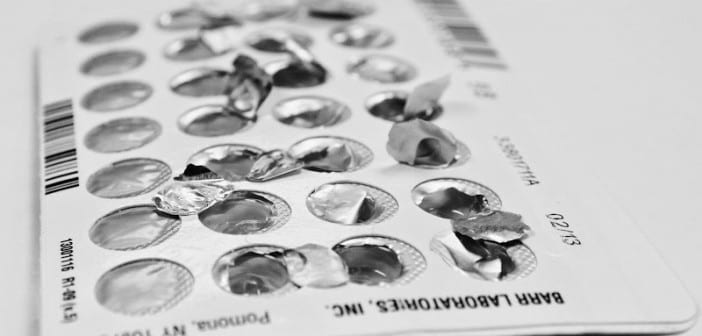Did you know that some forms of contraception – namely, hormonal birth control – can cause a woman's body to reject the newly-formed Life of a baby and expel him or her without the mother ever knowing she was pregnant? And did you also know that the major medical associations were complicit in duping the public into believing that this was not the case when hormonal contraception gained popularity? Here's what you need to know.
Some methods of family planning only prevent conception, and others prevent conception and have the potential to cause an abortion when a woman does conceive. Barrier methods (like condoms and diaphragms), fertility awareness methods (like Natural Family Planning), surgical methods (like vasectomies) and, of course, abstinence all carry no risk of abortion. If a baby is conceived while using one of these methods, no hormonal threat stands to deter the embryo from successful implantation in the mother’s womb.
But hormonal contraceptives, like the Pill, NuvaRing, patch, IUD, etc., are different. Because they alter a woman's body chemistry and physiology, hormonal contraceptives pose a risk to the survival of newly-conceived embryos by making the uterine environment hostile to implantation. This fact is readily acknowledged by medical groups and contraception manufacturers.
But one big loophole has allowed groups like the FDA and drug manufacturers to market hormonal birth control as only a contraceptive, and not an abortifacient: the American College of Obstetricians and Gynecologists (ACOG) changed the definition of conception and pregnancy from fertilization to implantation. This means that ACOG (the go-to American source for obstetricians) used to define “conception,” aka the beginning of “pregnancy” as occurring at the moment when sperm and egg join to create a new human being.
But now, ACOG defines the beginning of pregnancy as occurring when the embryo – which has likely been in existence for over a week – implants into the mother's uterus. And this definitional change was done precisely when the medical community faced the ethical dilemma of the Pill: doctors knew that the Pill was an abortifacient, not simply a contraceptive. But words have meaning, and the medical community knew that, and twisted the words used to define pregnancy for their own ends. Abort73 explains:
Why this change? The timing of their decision makes it almost certain that it was politically rather than scientifically motivated. The FDA had recently approved the sale of hormonal birth control pills, but “the pill” didn't fit the traditional definition of “contraceptive.” Why? Because it doesn't just prevent conception; it also inhibits implantation—or at least purports to. If breakthrough ovulation and fertilization occurs (which is the biological beginning of individual, human life), the embryo may find it difficult to implant because of changes the pill makes to the endometrium. This created an ethical problem for doctors who wanted to assure their patients that the pill is a contraceptive and not an abortifacient. How did they deal with the dilemma? They changed the definition of “conception.” By saying “conception,” but meaning “implantation,” it became possible to market hormonal birth control pills as contraceptives—as something that prevents “conception.”
Hormonal contraceptives tend to have a “failure” rate of between less than 1%, and 5%, meaning that breakthrough ovulation occurs despite the hormone alterations of the drug, allowing a woman to become pregnant. No hormonal contraceptive has a failure rate of 0%. There is always a risk that pregnancy will occur while a woman uses hormonal contraception if she's sexually active. An important note: the changes to the endometrium affected by hormonal birth control can still allow for implantation when a woman conceives (as many women who got pregnant while taking the Pill “religiously” can testify).
But many doctors argue that the thinning of the uterus can definitely cause a newly-conceived embryo to be expelled from a woman's body because the baby does not have the means to successfully implant in her womb. One such group of physicians states:
Most (virtually all) literature dealing with hormonal contraception ascribes a three-fold action to these agents. 1. inhibition of ovulation, 2. inhibition of sperm transport, and 3. production of a “hostile endometrium”, which presumably prevents or disrupts implantation of the developing baby if the first two mechanisms fail. The first two mechanisms are true contraception. The third proposed mechanism [the “hostile endometrium], IF it in fact occurs, would be abortifacient.
Further damning evidence comes from Richard Hill, a pharmacist in the product information department of one of the largest manufacturers of the Pill, Ortho-McNeil. In conversation with Randy Alcorn, a Pro-Lifer who had set out futilely to prove that the Pill does NOT act as an abortifacient, Hill told Alcorn that the Pill's (and, by extension, other types of hormonal birth control, which function under the same modes of operation) effect of making the uterine lining inhospitable to Life was very real and observable:
Oh, no, it’s not theoretical. It’s observable. We know what an endometrium looks like when it’s rich and most receptive to the fertilized egg. When the woman is taking the Pill, you can clearly see the difference, based both on gross appearance – as seen with the naked eye – and under a microscope. At the time when the endometrium would normally accept a fertilized egg, if a woman is taking the Pill it is much less likely to do so.
What are your thoughts on this topic? Share with us by commenting below.

